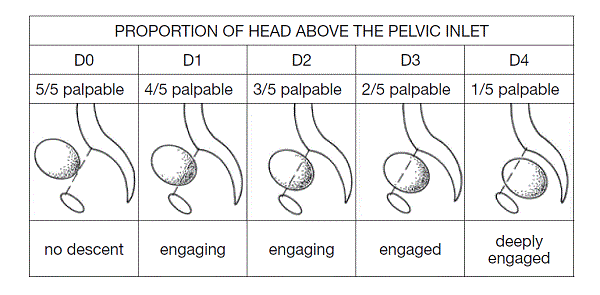Induction of labour
About 15-20% of women may require their labour to be "induced" or started for them. This is abbreviated as "IOL" or induction of labour. The Bishop score is used prior to induction of labour to assess the readiness or "ripeness" of the cervix and dose of medication required. A low score suggests that induction of labour is likely to take a longer time. In most New Zealand birthing units, a vaginal prostaglandin gel (eg Prostin) is used to ripen the cervix. In some situations, a balloon catheter into the cervix is used. Once the Bishop score is more than 5, an ARM (artificial rupture of membranes) is usually done, so that an intravenous oxytocin (Syntocinon) infusion can be used to start or increase contractions.
 What do you think?
What do you think?
| Here is the table from your book. What "position" is it that is being assessed in this context and what is meant by station? | |
| |
|
|
Once labour has started, how then will we know whether progress is going well or that perhaps it is actually too slow? Why do you think adequate progress in labour is important? A partogram is filled in for each woman in labour - you will see these being used in delivery suite.
Click on this PDF to see the partograpm that is used at National Women's - if you are at another cohort site compare with the one that is used there. They will probably be similar. This one has 2 sides and as you can see it contains a lot of information that helps to assess how labour is going. Have a look at all the parts to see what needs to be documented.
![]()
Partogram [view/annotate inline]
| 1. | At the top of page 1 - various maternal details such as blood group ,dates etc |
| 2. | The next table is to document fetal heart rate and maternal heart rate, temperature and BP over time along with details of liquor or show. |
3. | Then cervical dilatation and abdominal descent - i.e. how much of the fetal head can still be abdominally palpated – here is a diagram from your book to help you here. |
 | |
| 4. | Under this is whether the labour required use of oxytocin (Syntocinon). |
| 5. | What the contractions are like |
| 6. | What medications the woman is receiving |
| 7. | Urine output |
| 8. | Urinalysis |
| 9. | and then the signature of the person making the observations |
Over the page we have space for more detail of the vaginal examinations that have been carried out during labour. We asked you about position earlier on and of course it is the position of the fetal head that we are looking at. You will have worked this out in the previous activity section and in looking at the video. The position of the fetal head in the birth canal determines the diameter of the head which presents to the pelvis. If you feel you still haven't quite got it -have a look at page 61 of your book. During the vaginal examinations palpating for the fetal fontanelles will aid in accurate determination of the position of the fetal head in the pelvis.





